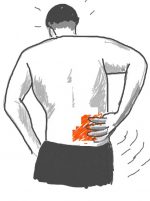28th July 2021, Dr Chee L Khoo

Muscular strains especially those around the spine (low back or neck pain) are very common presentations in general practice. Apart from analgesics, muscle relaxants are commonly prescribed. Recommendations for the use of muscle relaxants have, however, conflicted between international clinical practice guidelines for low back pain (1,2). The US guideline recommends non-benzodiazepine antispasmodics as the drug of choice for acute low back pain (3) the Belgian guideline discourages such use (4) and the UK guideline does not make a recommendation (5). Although muscle relaxants are typically prescribed for short term use, the effects of long term use are not known. Should we be using a muscle relaxant for treatment of muscular strains?
A systematic review performed in October 2015 suggested that muscle relaxants produced clinically meaningful reduction in pain intensity in people with acute back pain. Since then, there have been a number large randomised control trials published. A more recent systematic reviewed the evidence to estimate the efficacy, acceptability, and safety of muscle relaxants compared with placebo, usual care, or no treatment in adults with low back pain. The results were published in British Medical Journal (BMJ) recently (6).
31 trials involving 6505 participants were included in the quantitative analysis. These trials included adults (≥18 years) with non-specific low back pain who receive a systemically administered dose of a spasmolytic muscle relaxant compared with a non-active control group (sham (placebo) drug, continuation of usual care, waiting list, or no treatment). The primary outcomes were pain intensity and acceptability (satisfaction with the treatment regimen measured by the number of patients who discontinued treatment for any reason). Secondary outcomes were disability, adverse events serious adverse events and withdrawal from treatment because of adverse effects.
Results
The meta-analysis found very low certainty evidence that non-benzodiazepine antispasmodic drugs might reduce pain intensity at two weeks or less for patients with acute low back pain. This effect is small—less than 8 points on a 0–100 point scale—and does not meet common thresholds to be clinically meaningful. Non benzodiazepine antispasmodics might have little to no effect on pain intensity at 3-13 weeks or on disability at all follow-up time points. Low and very low certainty evidence showed that non-benzodiazepine antispasmodics might increase the risk of adverse events (commonly, dizziness, drowsiness, headache, and nausea) and might have little to no effect on treatment discontinuation, respectively.
Implications
This review shows the uncertainty of evidence for the efficacy and safety of muscle relaxants. Although non-benzodiazepine antispasmodics might reduce pain intensity at two weeks or less for acute low back pain, the effect is not considered to be clinically important. Although muscle relaxants are typically prescribed for short term use, the effects of long term use are not known. High quality data are required to evaluate the efficacy and safety of long term use. This is particularly
important when considering that the risk of dependency and misuse associated with muscle relaxants has been observed from indirect evidence.
References:
- Schreijenberg M, Koes BW, Lin CC. Guideline recommendations on the pharmacological management of non-specific low back pain in primary care – is there a need to change?Expert Rev Clin Pharmacol 2019;12:145-57. doi:10.1080/17512433.2019.1565992.
- Oliveira CB, Maher CG, Pinto RZ, et al. Clinical practice guidelines for the management of non-specific low back pain in primary care: an updated overview. Eur Spine J 2018;27:2791-803. doi:10.1007/s00586-018-5673-2.
- Qaseem A, Wilt TJ, McLean RM, Forciea MA, Clinical Guidelines Committee of the American College of Physicians. Noninvasive Treatments for Acute, Subacute, and Chronic Low Back Pain: A Clinical Practice Guideline From the American College of Physicians. Ann Intern Med 2017;166:514-30. doi:10.7326/M16-2367.
- Van Wambeke P, Desomer A, Ailliet L, et al. Low back pain and radicular pain: assessment and management. KCE Report 287. Belgian Health Care Knowledge Centre, 2017. https://kce.fgov.be/sites/default/files/atoms/files/KCE_287_Low_back_pain_Report.pdf
- National Institute for Health and Care Excellence. Low Back Pain and Sciatica in Over 16s: Assessment and Management. NICE, 2016. https://www.nice.org.uk/guidance/ng59
- Cashin AG, Folly T, Bagg MK, Wewege MA, Jones MD, Ferraro MC, Leake HB, Rizzo RRN, Schabrun SM, Gustin SM, Day R, Williams CM, McAuley JH. Efficacy, acceptability, and safety of muscle relaxants for adults with non-specific low back pain: systematic review and meta-analysis. BMJ. 2021 Jul 7;374:n1446. doi: 10.1136/bmj.n1446. PMID: 34233900; PMCID: PMC8262447.
